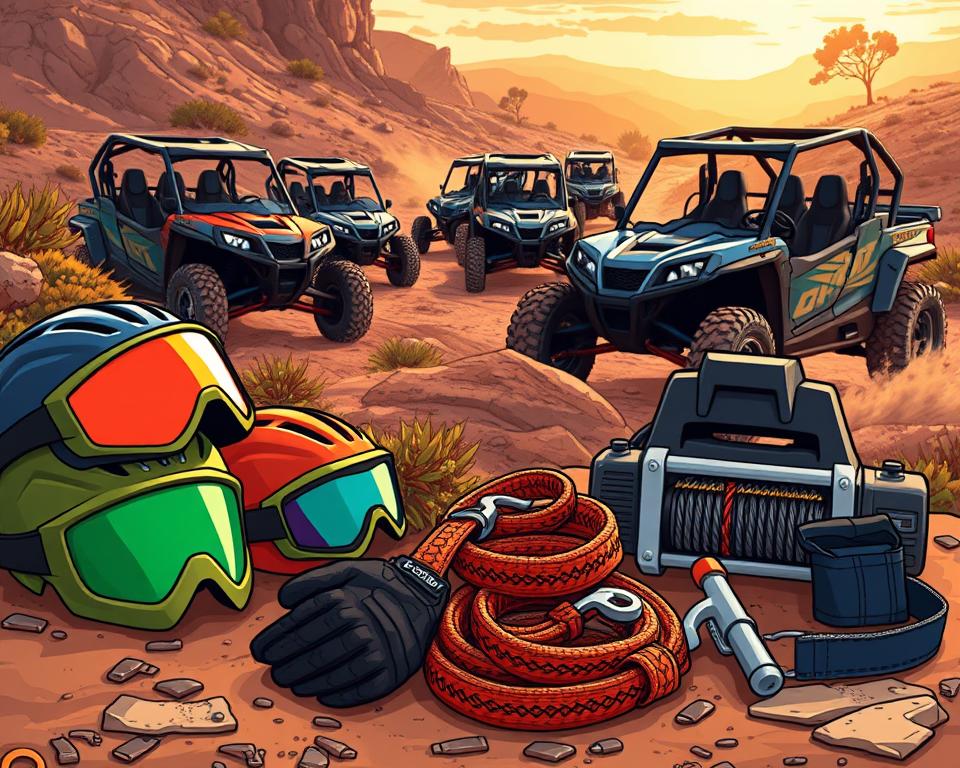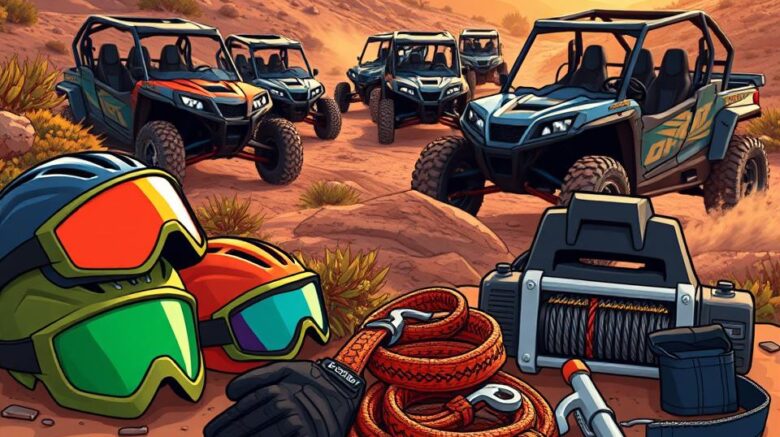Steering Clear of ATV/UTV Gearing Errors for Novices
Are you aware that nearly 30% of new ATV and UTV owners face gear selection issues within their first year? Such data emphasizes how critical gear ratios are for novice riders. It’s not just about performance; it’s also about safety on the trails. We’ll explore common mistakes, maintenance practices, and expert highlifters advice to improve your off-road adventures.
Essential Insights

- Mastering gear ratios unlocks top performance.
- Common gearing oversights can lead to safety risks on the trails.
- Routine care averts transmission breakdowns.
- Smart gear choices transform your outdoor rides.
- Applying service recommendations increases longevity.
Understanding ATV and UTV Gear Ratios
Gear ratios are vital for the performance of ATVs and UTVs. They dictate how engine power translates into speed and torque. That impacts hill climbs and tow capabilities. By picking specific ratios, you tailor your ride for drag, trail, or work.
Picking the correct ratio optimizes power delivery. Excessively low gearing reduces hill-climbing pull. Overgearing sacrifices quickness for top-end speed.
Riders often tweak reduction ratios for trail versatility. Ratio mods shape how your rig behaves off-road. This ensures the machine operates efficiently, whether prioritizing speed or torque. Finding the sweet spot in gearing enhances ride quality and fuel economy.
Common Gearing Oversights for New ATV/UTV Owners
Choosing the right gear is key to optimal performance and safety when riding an ATV or UTV. First-timers frequently ignore ratio considerations. Understanding the effects of wrong gear choices and selecting the right one for your terrain can greatly improve your ride. And it sidesteps needless breakdowns.
Impact of Incorrect Gear Selection
Misgearing risks crashes and costly damage. Poor gear choice dampens speed, stresses brakes, and accelerates wear. These mishaps compromise safety for all on and off board. Using maintenance best practices wards off these hazards.
Choosing the Right Gear for Terrain
Each surface demands its own ratio. To conquer grades, use lower speeds and higher torque. To cover ground quickly, shift to higher ratios. Soft ground demands careful gear choice for grip. Recognizing terrain traits delivers safer, smoother rides.
The Importance of Proper ATV Maintenance
Routine upkeep ensures reliable performance. Using upkeep best practices stops breakdowns and protects riders. A well-planned maintenance schedule focuses on the gear system’s health.
Regular Inspection and Maintenance
Using a checklist uncovers faults before they escalate. Regularly inspect the drive train, stopping systems, wheels, and belts. By making this checklist a part of your routine, you can greatly enhance your vehicle’s performance. Here are some critical inspection points to remember:
- Inspect gearbox alignment and pitting.
- Verify hardware and linkages are secure.
- Assess brake fluid and hydraulic systems.
- Measure wheel pressure and wear.
- Review electrical systems for corrosion.
Fluid Changes and Gear Health
Fluid quality is critical for UTV drivetrain maintenance. Frequent changes clear out contaminants. Clean fluids ensure smoother operation and reduce friction, extending the life of vital parts. By following these practices, you can maintain your gear in top condition, ensuring reliable performance on every ride.
| Fluid Type | Recommended Change Interval | Benefits of Regular Change |
|---|---|---|
| Motor Oil | 50–100 operating hours | Cuts friction and boosts power |
| Gear Oil | Every 100-200 hours | Smooths shifts and prevents pitting |
| Antifreeze | Annually | Stops boil-overs and freezes |
Adhering to this schedule grants worry-free adventures. That boosts confidence and enjoyment.
Common ATV Gear Shifting Problems
New ATV riders often face challenges with gear shifting. Developing fluid shift skills elevates trail enjoyment. You avoid jerky starts and stops. Synchronizing engine speed and clutch engagement stops misshifts.
Learning to Shift Smoothly
Developing smooth shifting techniques requires a few practices. First, feel your engine’s rev pattern. Gentle shifts spare your gearbox and extend service life. Matching revs while you let out the clutch is essential.
Drill shifts in an open space to build skill. Focus on gentle throttle application during each gear change.
Recognizing Signs of Gear Issues
Catching faults early saves time and money. Watch for whines, clanks, or crunches in the gearbox. Hard shifts or missed gears indicate trouble. Fixing problems fast keeps you safer on the trail. Addressing ATV gear shifting problems properly maintains vehicle performance and boosts your confidence while riding.
Understanding UTV Transmission Issues
UTV gearbox troubles challenge many owners, so familiarity helps diagnose. Owners often face issues like slipping gears or odd noises. Below we break down common failures and the tools to troubleshoot them. It’s based on a practical UTV troubleshooting guide.
Diagnosing Common Problems
Identifying symptoms early prevents bigger issues. Common issues include:
- Slipping gears that threaten control and safety.
- Weird whines or crunches hinting at worn parts.
- Signs of fluid seepage that threaten gearbox health.
Scheduled inspections catch problems fast. It lets you fix faults before they worsen. Ignoring these signs can lead to expensive repairs and reduced performance.
Solutions for Troubleshooting UTV Transmissions
Fixing UTV transmission issues requires a systematic approach. Follow these steps for effective troubleshooting:
- Ensure gearbox fluid is at spec, then add if low.
- Inspect pan and seals for drips.
- Inspect the gearbox for wear or damage.
- Operate the UTV under different loads to observe shift quality.
- Reference factory troubleshooting charts for your UTV.
Using a reliable UTV troubleshooting guide can streamline the process. Understanding gear mechanics is key for any UTV owner. That insight preserves reliability and output.
ATV Clutch Adjustments and Their Benefits
Proper ATV clutch adjustments are key to a great riding experience. Misadjusted clutches cause jerky shifts and rider irritation. Frequent tuning enhances clutch grip and shift precision.
Precision in gear changes is critical. Correctly calibrated clutches enable flawless transitions. It refines acceleration and comfort across all conditions.
Skipping clutch care leads to early failures and poor shifts. Consistent adjustments sustain peak clutch function. It’s critical for both new and seasoned riders to ensure their ATV performs at its best.
Mastering the Art of Gear Shifting
Mastering gear shifting techniques greatly enhances your riding experience. It requires knowledge of your vehicle’s mechanics and developing a keen sense of timing and spatial awareness. Rookies need to practice gear timing. A comfortable cadence leads to smoother transitions and improved performance.
Skillful shifting comes from drilling in diverse environments. Understanding when to shift gears based on terrain type enhances control and safety. Dropping a gear before a climb preserves torque and control.
- Practice shifting at low speeds to build confidence.
- Listen and feel each gear engagement.
- Step up to steeper, rougher trails as you improve.
Getting in sync with your ride ensures perfect shifts. Listen for pitch changes and shudders to guide engagements. This helps determine the optimal moments to shift. That instinctive skill yields seamless shifts and more fun.
Best Practices for UTV Gear Selector Problems
Resolving gear lever faults requires regular inspection and testing. Routine linkage reviews catch wear promptly. By mastering gear selection techniques, operators can avoid malfunctions. Routine checks should include visual inspections of the selector linkage and fluid levels, which are vital for performance.
When facing gear selector issues, first check the selector mechanism for obstructions or damage. Squeaks might indicate misalignment. Simple adjustments and cleaning often solve issues without needing major repairs. Scheduled servicing prevents selector degradation.
Logging selector behavior in varied rides highlights issues. Following these methods preserves selector health and rider trust.
Tips for Enhancing Gear Performance
Maintaining optimal gear performance requires a proactive approach. Scheduled upkeep enhances ATV efficiency. Monitor fluids, look for damage, and fine-tune as required. A simple inspection can prevent extensive damage and costly repairs.
Picking ideal ratios unlocks quicker revs and seamless cruisin’. Assessing ground conditions guides your ratio picks. This decision impacts everything from acceleration to top speed. Seeking parts from specialists such as American Off-Roads aids in UTV performance enhancements.
Applying gear performance tips across tires, shocks, and load balance boosts efficiency. Making these adjustments ensures that both ATVs and UTVs handle better in challenging environments. This leads to a more enjoyable riding experience. These steps ensure fearless exploration and maximum excitement on the trail.
Bringing It All Together
Nailing gear selection unlocks peak power and protection. Knowing how to choose the right gear for different terrains greatly improves your ride. By avoiding common mistakes and making smart choices, your off-road trips will be both fun and secure.
You can’t overemphasize regular service for power health. Scheduled maintenance and TLC save you from breakdowns and prolong service. Good upkeep maximizes output and secures your rides in all conditions.
Combining correct gearing with scheduled service delivers peak satisfaction for riders. Following these guidelines paves the way for endless trail excitement.
FAQ
Common ratio ranges for ATVs/UTVs?
Ratio specs differ greatly by manufacturer and use case. Typical ratios lie within the 3-to-5 range. Low-end ratios yield higher pulling power. Higher ratios, on the other hand, can increase top speed on flat terrain.
How to spot unsuitable gearing?
Using the wrong gear can lead to loss of control, excessive engine revving, or poor acceleration. Mud, sand, rocks, and snow each call for tailored gear choices.
How to know when your machine needs service?
Head off issues if shifts go crunchy, the box hums, oil drips, or power falls off. Regular checks of the gear system can prevent major issues.
Recommended fluid change intervals?
Aim for a fluid swap between 1,500–2,500 miles or annually, whichever comes first. Fresh fluids promote crisp shifts and gearbox longevity.
What techniques should I use for smooth gear shifting?
Master the throttle-clutch dance for silky shifts. Feather the clutch up while winding the throttle for a perfect match.
Steps to diagnose gearbox problems?
Begin with fluid level checks and a listen for whines or grinds. Inspect the transmission fluid level and condition. Then, perform a basic diagnostic to identify any mechanical failures.
What is the importance of clutch adjustments in an ATV?
Well-set clutches ensure crisp gear changes. Bad clutch alignment wears out parts prematurely and hinders shifts.
How can I improve my gear performance on different terrains?
Test multiple gearing options and look into quality mods by American Off-Roads. Routine upkeep—fluid swaps and gear checks—boosts efficiency.
What should I do if my UTV gear selector is malfunctioning?
Frequent checks and service stops selector snags. If you encounter issues with a stuck selector or improper gear engagement, consult the troubleshooting guide in your owner’s manual for step-by-step diagnostics.
Beginner pitfalls in gear selection?
New owners often overlook the importance of understanding gear ratios, neglect routine maintenance, or fail to adjust gears according to terrain. Such errors cause subpar power delivery and increased accident risk.
